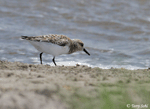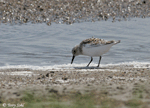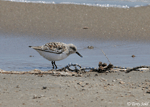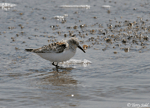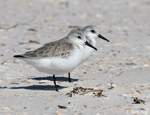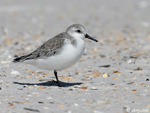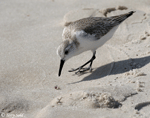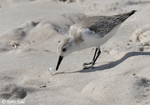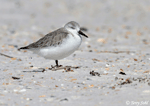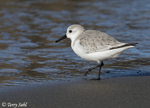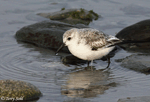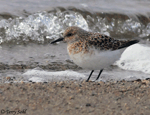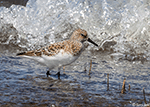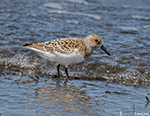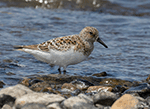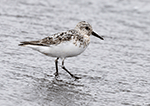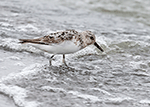Sanderling
Calidris alba
| Length: 8 inches | Wingspan: 15 inches | Seasonality: Migrant |
| ID Keys: Black smudge on shoulder, strong white wing stripe, black legs, sturdy black bill | ||
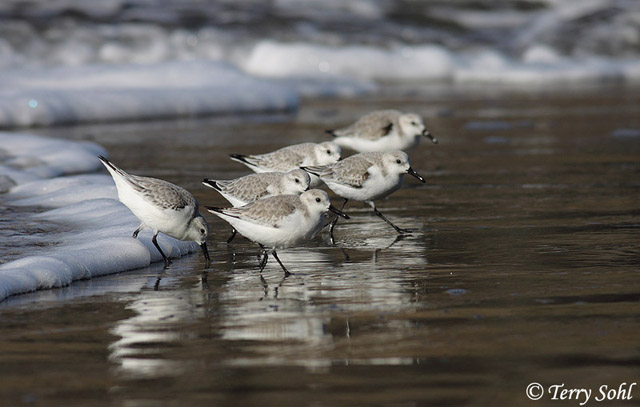 The
Sanderling is a common sight on U.S. coastlines in the winter, moving up and
down sandy beaches in advance and retreat of waves (see photo to the right). They strongly prefer
sandy beaches in the winter, and their pale plumage often matches the pale sand
on which they forage. Individual birds often return to the same wintering
sites each year. Destruction or heavy human use of winter beach habitat
has resulted in sharp declines in recent decades.
The
Sanderling is a common sight on U.S. coastlines in the winter, moving up and
down sandy beaches in advance and retreat of waves (see photo to the right). They strongly prefer
sandy beaches in the winter, and their pale plumage often matches the pale sand
on which they forage. Individual birds often return to the same wintering
sites each year. Destruction or heavy human use of winter beach habitat
has resulted in sharp declines in recent decades.
Habitat:
In summer, found on dry rocky tundra close to ponds and lakes. At other seasons, they are generally found on sandy beaches and occasionally on rocky coastlines.
Diet:
On summer breeding grounds, primarily feeds on insects and insect larvae, as well as some vegetation. In winter and in migrations, feeds on sand crabs, small mollusks and crustaceans, amphipods, isopods, and marine worms. In spring, they often stopover to feed heavily on horseshoe crab eggs. They have also learned to eat human food that has been discarded.
Nesting:
Non-breeder in South Dakota. In breeding range, the nest of a Sanderling is a shallow depression on the ground, lined with bits of vegetation. The female lays 3 or 4 eggs, and both parents help to incubate them. When the eggs hatch, the young quickly leave the nest and feed themselves, but are usually tended by both parents. Sometimes only one parent tends the young. The young typically fledge by about 18 days.
Song:
The most often heard vocalization is a soft kweep call note.
- Click here to hear the calls of a Sanderling1
- Click here to hear the calls of a group of Sanderling2
Migration:
Summers in the high Arctic. Winters along all coastlines of the U.S. and southward. Also found in the Eastern Hemisphere, and they can be found nearly worldwide in the winter.
Interactive eBird Map:
Click here to access an interactive eBird map of Sanderling sightings
Similar Species:
With their very pale, ghostly winter (non-breeding plumage), and their rich, chestnut-colored breeding plumage, identifying Sanderlings is more straightforward than many other small shorebird species that could be fond in South Dakota. Here are the other shorebird species that could potentially be confused with a Sanderling:
- Dunlin - In breeding plumage the two species aren't likely to be confused with each other, particularly given a breeding-plumaged Dunlin's bold black belly patch. In non-breeding plumage, however, both species are relatively plain, with white underparts and darker upperparts. However, non-breeding Dunlin are a light brownish-gray on their upperparts, while non-breeding Sanderlings are a pale gray. In all plumages, Dunlin are also easily differentiated from Sanderlings by their longer, drooping bill.
- Least Sandpiper - A common small sandpiper migrant in the state, in all plumages they can be differentiated from Sanderlings by their yellow legs (black on a Sanderling) and smaller size. In non-breedng plumage Least Sandpipers usually aren't as colorful as a breeding plumaged Sanderling.
- Semipalmated Sandpiper - Semipalmated Sandpipers are another small sandpiper that commonly migrates through the state. They are smaller than a Sanderling, and in breeding plumage, have more white and lighter tones mixed in with what can be some colorful rusty tones on their upperparts and head. In non-breeding plumage, Semipalmated Sandpipers are browner and less pale than a Sanderling..
- Red Knot - In South Dakota, Red Knots are a rare migrant, but in range, they can be confused with a Sanderling. In breeding plumage Red Knots have extensive rusty coloring on their undersides, while breeding plumage Sanderlings have more limited rusty coloring in on the upper breast and back. In non-breeding plumage both species are much plainer, but Red Knots have browner and less pale upperparts, and also have less of a "clean" look on their underside compared to the stark white of a Sanderling.
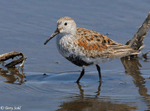 |
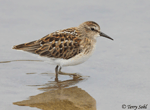 |
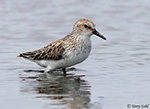 |
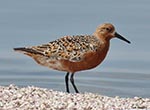 |
| Dunlin | Least Sandpiper | Semipalmated Sandpiper | Red Knot |
Conservation Status:
Systematic surveys in the last few decades have estimated generally stable populations of Sanderlings. They are still found over a very wide geographic area, they are common in parts of their range, and overall populations are strong. The IUCN lists the Sanderling as a species of "Least Concern".
Further Information:
Photo Information:
December 9th, 2011 - Pacific Coast near San Francisco, California - Terry Sohl
Additional Photos:
Click on the image chips or text links below for additional, higher-resolution Sanderling photos.
Audio File Credits
- 1Jack Berteau. Recorded in France on September 16th, 2020. Original recording and information available on xeno-canto.
- 2Stanislas Wroza. Recorded in France on September 12th, 2020. Original recording and information available on xeno-canto.
| Click on the map below for a higher-resolution view |
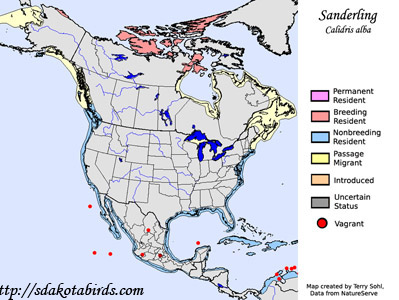 |
| South Dakota Status: Uncommon migrant in the eastern part of the state, rare in the west. |
Additional Sanderling Photos
Click for a higher-resolution version of these photos
